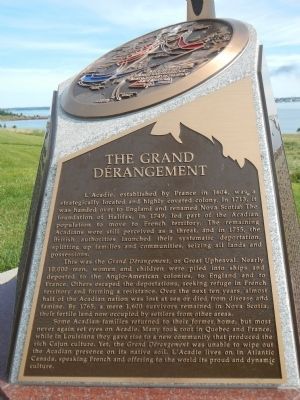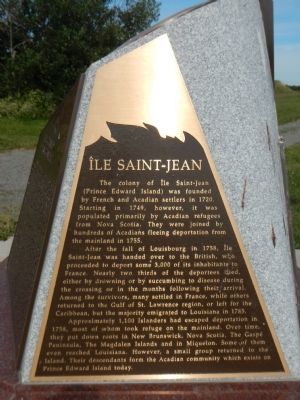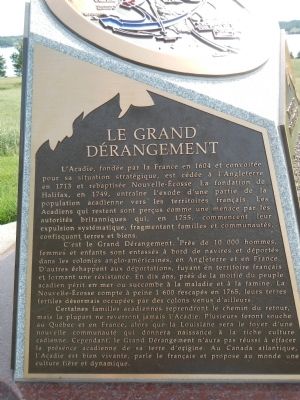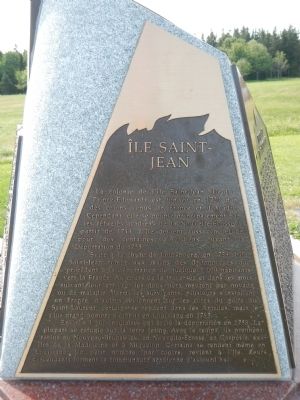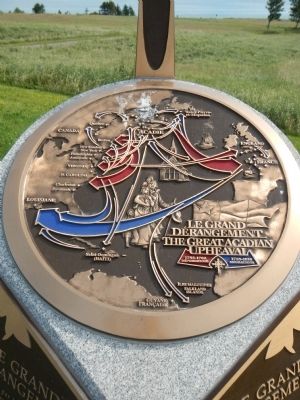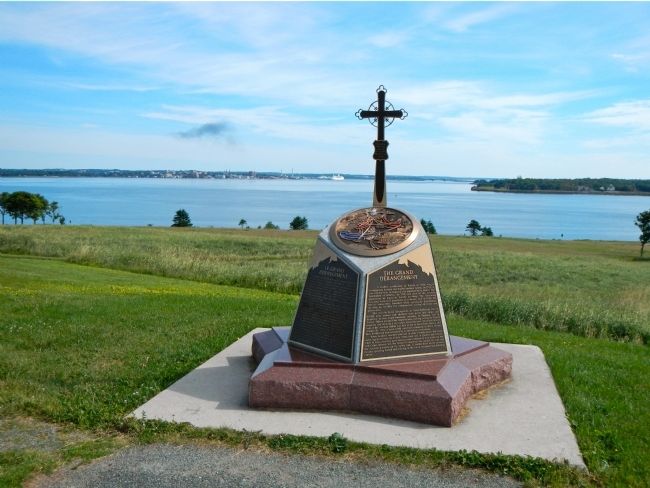Rocky Point in Queens County, Prince Edward Island — The Atlantic Provinces (North America)
The Grand Dérangement
Île Saint-Jean
L’Acadie, established by France in 1604, was a strategically located and highly coveted colony. In 1713, it was handed over to England and renamed Nova Scotia. The foundation of Halifax, in 1749, led part of the Acadian population to move to French territory. The remaining Acadians were still perceived as a threat, and in 1755, the British authorities launched their systematic deportation, splitting up families and communities, seizing all lands and possessions.
This was the Grand Dérangement or Great Upheaval. Nearly 10,000 men, women, and children were piled into ships and deported to Anglo-American colonies, to England and to France. Others escaped the deportation, seeking refuge in French territory and forming a resistance. Over the next ten years, almost half of the Acadian nation was lost at sea or died from disease and famine. By 1765, a mere 1,600 survivors remained in Nova Scotia, their fertile land now occupied by settles from other areas.
Some Acadian families returned to their former home, but most never again set eyes on Acadie. Many took root in Quebec and France, while in Louisiana they gave rise to a new community that produced the rich Cajun culture. Yet, the Grand Dérangement was unable to wipe out the Acadian presence on its native soil. L’Acadie lives on in Atlantic Canada, speaking French and offering to the world its proud and dynamic culture.
The colony of Île Saint-Jean (Prince Edward Island) was founded by French and Acadian settlers in 1720. Starting in 1749, however, it was populated primarily by Acadians refugees from Nova Scotia fleeing deportation from the mainland in 1755.
After the fall of Louisbourg in 1758, Île Saint-Jean was handed over to the British, who proceeded to deport some 3,000 of its inhabitants to France. Nearly two thirds of the deportees died, either by drowning or by succumbing to disease during the crossing or in the months following their arrival. Among the survivors, many settled in France, while others returned to the Gulf of St. Lawrence region, or left for the Caribbean, but the majority emigrated to Louisiana in 1785.
Approximately 1,100 Islanders had escaped deportation in 1858, most of whom took refuge on the mainland. Over time, they put down roots in New Brunswick, Nova Scotia, The Gaspé Peninsula, The Magdalen Islands and in Miquelon. Some of them even reached Louisiana. However, a small group returned to the Island. Their descendants form the Acadian community which exists on Prince Edward Island today.
French:
L’Acadie, fondée par la France en 1604 et convoitée pour sa situation stratégique, est cédée à l’Angleterre en 1713 et rebaptisée Nouvelle-Écosse. La fondation de Halifax, en 1749, entraîne l’exode d’une partie de la population acadienne vers les territories français. Les Acadiens qui restent son perçus comme un menace par les autorités britannique qui, en 1755, commençant leur expulsion systématique, fragmentant familles et communautés, confisquant terres et bien.
C’est la Grand Dérangement. Près de 10 000 hommes, femmes et enfants son entassés à bord de navires et déportes dans les colonies anglo-américaines, en Angleterre et en France. D’autres échappent aux déportations, fuyant en territoire français et formant une résistance. En dix ans, près de la moitié du peuple acadien périt en mer ou succombe à la maladie et à la famine. La Nouvelle-Écosse compte à peine 1 600 rescapés en 1765, leur terres fertiles désormais occupées par des colons venus d’ailleurs.
Certaines familles acadiennes reprendront le chemin du retour, mais le plupart ne reverront jamais l’Acadie. Plusieurs feront souche au Québec et en France, alors que la Louisiane sera le foyer d’une nouvelle communauté qui donnera naissance à la riche culture canadienne. Cependant, le Grand Dérangement n’aura pas réussi à effacer la présence acadienne de sa terre d’origine. Au Canada atlantique, l’Acadie est bien vivante, parle le français et propose au monde une culture fière et dynamique.
La colonie de L’île Saint-Jean (Île-du-Prince-Edouard) est fondée en 1720 par des colons de France et d’Acadie. Cependant, elle se peuple principalement par les réfugiés acadiens de la Nouvelle-Écosse a partier de 1749. L’île devient aussi un refuge pour des centaines d’Acadiens fumant la Déportation de 1755.
Suite à la chute de Louisbourg en 1758 l’ile Saint-Jean tombe aux mains des Britanniques qui procèdent à la déportation de quelque 3 000 habitants vers la France. Au cours de la traversée en dans les mois suivant leur arrivée les deux tiers meurent par noyade ou de maladie. Parmi les survivants, plusieurs s’installent en France, d’autres reviennent sur les côtes du golfe du Saint- Laurent; certains se rendent dans les Antilles, mais du plus grand nombre s’établit en Louisiane en 1785.
Environ 1 100 insulaires ont évite la déportation en 1758. La plupart se réfugie sur la terre ferme. Avec le temps, ils prennent racine au Nouveau-Brunswick, en Nouvelle-Écosse,en Gaspésie, aux en îles de la Madeleine et a Miquelon. Certains se rendent même en Louisiane. Un petit nombre, par contre, revient à l’île. Leurs descendants forment la communauté acadienne d’aujourd’hui.
Erected by The Arcadian Odyssey.
Topics. This historical marker is listed in these topic lists: Colonial Era • Disasters • War, French and Indian. A significant historical year for this entry is 1604.
Location. 46° 11.828′ N, 63° 8.163′ W. Marker is in Rocky Point, Prince Edward Island, in Queens County. Marker can be reached from Hache Gallant Drive close to Blockhouse Road, on the left when traveling east. Touch for map. Marker is in this post office area: Rocky Point PE C0A 1H2, Canada. Touch for directions.
Other nearby markers. At least 8 other markers are within walking distance of this marker. A Human Tragedy / Une tragédie humaine (a few steps from this marker); A Great Survey / Un Arpentage de Taille (within shouting distance of this marker); The British Period / La période britannique (within shouting distance of this marker); Michel Haché-Gallant (within shouting distance of this marker); Port of Entry / Port d’entrée (about 90 meters away, measured in a direct line); The Mi'kmaq / Les Mi'kmaq (about 150 meters away); Place Yourself in History / Situez-vous dans l’histoire (about 150 meters away); Michel Haché-Gallant et Anne Cormier (about 180 meters away). Touch for a list and map of all markers in Rocky Point.
More about this marker. This marker is on the grounds of Port-la-Joye -- Fort Amherst National Historic Site, northeast from the visitors center.
Regarding The Grand Dérangement. This star-shaped monument placed by The Acadian Odyssey is one of 38 planned monuments to The Grand Dérangement (The Great Upheaval). Only 8 have been placed so far.
Related marker. Click here for another marker that is related to this marker. To better understand the relationship, study each marker in the order shown.
Also see . . .
1. The Exile - Acadian-Cajun Genealogy & History. About 6,000 Acadians were exiled from Port Royal, Grand Pre, and Beaubassin in 1755 to the American Colonies and England (via Virginia). Over 3,000 more were exiled after the fall of Louisbourg in 1758 and sent to France. When the war ended in 1763, the Exile was technically over. Between 1755 and 1785, Acadians migrated to several other locations. (Submitted on January 15, 2015, by Barry Swackhamer of Brentwood, California.)
2. Monuments commemorating the Great Upheaval - Wikipedia. Many monuments were erected around the world to commemorate the Great Upheaval (massive expropriation and expulsion of the Acadians, French-speaking people of America, during the taking of possession by the British, the former French colonies in America, in the eighteenth century). (Submitted on January 15, 2015, by Barry Swackhamer of Brentwood, California.)
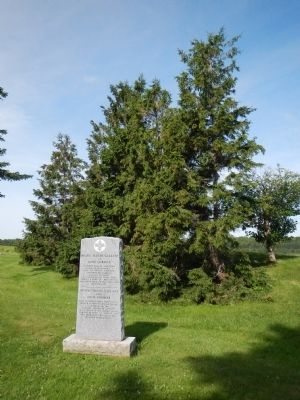
Photographed By Barry Swackhamer, July 11, 2014
7. Michel Hache-Gallant and Anne Cormie Monument
and
Anne Cormier
First Acadian family permanently settled in Prince Edward Island
Ancestors of the Gallant and Hache families of Canada and the United States arrived at Portpla-Joye in 1620
This Monument erected in 1965 by their descendants.
Michel Hache-Gallant
et
Anne Comier
Premier famille acadienne établie en permanence à L’ile-du-Prince-Edouard
Ancêtres des families Gallant et Hache
du Canada et des États-Unis
arrivés à Port-la-Joye en 1720
Monument érigé en 1965 par leurs descendants
Credits. This page was last revised on June 26, 2020. It was originally submitted on January 15, 2015, by Barry Swackhamer of Brentwood, California. This page has been viewed 769 times since then and 53 times this year. Last updated on January 22, 2015, by J. Makali Bruton of Accra, Ghana. Photos: 1, 2, 3, 4, 5, 6, 7. submitted on January 15, 2015, by Barry Swackhamer of Brentwood, California. • Andrew Ruppenstein was the editor who published this page.
